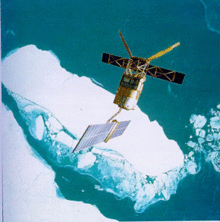European Remote Sensing Satellite
The European Remote Sensing Satellite (ERS) became the first Earth observation satellite launched by the European Space Agency (ESA), when it was launched on July 17, 1991, by an Ariane 4 from Kourou, French Guiana, into a sun-synchronous polar orbit at an altitude of between 782 and 785 km.
ERS-1 carried a series of Earth-observing instruments that collected data about our planet:
- A radar altimeter operating in the Ku band
- A four-channel infrared radiometer to measure temperatures on the surface of the sea and at the top of the clouds
- A microwave emitter
- A synthetic opening radar
- A scaler for wind study
To accurately determine its orbit, the satellite included PRARE (Precision Range and Range-Rate Equipment) and a laser retroreflector. PRARE was never operational, and the retroreflector was used to calibrate the altimeter.
A failure of the ERS-1 computer and gyroscopes caused the end of operations on March 10, 2000, much later than originally planned.
Its successor, ERS-2, was launched on April 21, 1995 also by an Ariane 4 from Kourou. It is practically the same as ERS-1, but with the addition of the GOME (Global Ozone Monitoring Experiment) and an absorption spectrometer. When ERS-2 was launched, it shared the same orbital plane with ERS-1, which made a "tandem" mission possible, with ERS-2 passing through the same area that ERS-1 had traveled. one day before.
ERS-2 has been operating without gyroscopes since February 2001, which has meant a degradation in some data obtained by the instruments. On June 22, 2003, there was a serious failure on board, so the instruments only work when the satellite is visible from some ground station. Since this failure became known, some additional ground stations have been enabled to increase the data collection capacity of the satellite. The scatterometer and GOME were the only instruments of their kind in orbit until the 2006 launch of MetOp.
The successor to the ERS-2 is the Envisat
Contenido relacionado
Geostationary transfer orbit
Astronautics
WMAP
Annex: American interplanetary probes
ESA (disambiguation)
